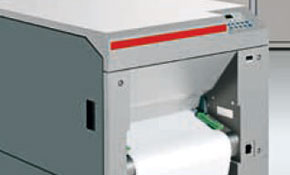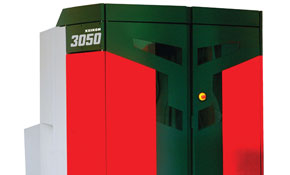
Many print business owners would have a fondness for the first machine that set them on their business journey. More often than not, it was a basic, entry-level piece of kit, cheap and cheerful, which was gradually outpaced by rising demand from customers and a broadening market for the company. Or it could have been cheap and not so cheerful, underpowered, unreliable, a headache to operate and maintain, and a testament to the dictum of ‘buy cheap, buy twice’.
Well-built basic machinery is still ticking over in many companies, some of it as a sideline to the main activity now performed on higher-spec equipment. In other cases, base-level gear did not match expectations.
At Valley Edge Design Centre in Brisbane, director Rocky Cassaniti tells a war story about an early piece of machinery that needed a lot of TLC and was eventually taken back by the vendor when things went awry. No names, no pack drill, he tells ProPrint, but the tale goes like this: “We started with a colour output machine, which I cannot name due to the fact that we sent it back, as it did not perform as requested. Valley Edge used this machine to print flyers, reports, advertising materials and stationery. Within one year, it was evident that this machine was not able to provide the high level of output that Valley Edge is accustomed to producing.”
The vendor had agreed to a written list of requirements for the machine and it was simply not fulfilling the promises made, says Cassaniti. “Limitations included inferior printing. Simple. There were colour variations, banding – in all, a sub-standard print in my opinion. They were very co-operative, even though they lost the business, but they were happy to oblige.”
The digital press was eventually sold to another customer, he recalls.
However, Cassaniti says that the experience at Valley Edge was not totally without merit. “The entry-level machine enabled us to be more competitive on smaller run jobs.”
Cassaniti believes vendors generally try to promote the biggest and best in their range, but 24-year-old Valley Edge Design had a firm strategy for how it wanted to start out in business. “Our decision was based on our budget for new machinery without compromise of quality production.”
Nowadays, Valley Edge runs an array of higher-spec’d hardware in digital production printing, and for some time now also large-format. For cutsheet digital, there’s a Canon ImagePress 6000 with EFI Fiery controller. For wide-format, there’s a Roland DG VersaCamm V6 640 eco-solvent printer running Roland’s VersaWorks workflow.
But sometimes it’s difficult to know what to do with kit that becomes surplus to requirements due to changed circumstances. Paying top dollar for state-of-the-art hardware might not seem like such a great deal later when it is no longer needed.
During the GFC, Valley Edge outsourced its offset printing business, which it had taken on in 2002 through the acquisition of another printer. It now uses a partnership with a trade printer instead. This required the sale of its two- and five-colour Heidelberg Speedmasters and it also means it no longer needs its recently acquired, top-of-the-line Agfa Avalon N4 thermal platesetter, which fed the Speedmasters with Azura plates from an Apogee workflow. Valley Edge has since advertised the one-year-old platesetter in ProPrint’s Marketplace section.
In-house or outsource
Multimedia direct marketing and print operation Prografica upgraded to a top-of-the-range Lanier Pro C751EX production digital machine in March. The new arrival can handle large volumes of envelope printing for DM runs. “This was something we used to send out, now we can do it internally,” says Prografica managing director Kerim El Gabaili.
Particularly attractive for Prografica is the Lanier’s ability to print variable data on the envelopes. The machine replaces a Canon C7000VP press, which could not handle envelope printing on a similar scale. “With the Lanier, we can stack the envelopes in the drawer and each batch can be printed differently.”
That said, El Gabaili does not believe a highly spec’d machine is always the answer. He is emphatic that entry-level presses can sometimes be the best solution. It all depends on what they are required to do.
“It depends on what market you’re looking to grow. You may opt for that high-spec machine because you want to grow a particular part of your business. But I wouldn’t rush out and get a fully spec’d machine unless I have a reason for doing it.
“Most printers going into digital, the first thing they’ll do is start taking work off their offset machines. That’s the easiest transition. Then they’ll start thinking about short-run opportunities on their digital presses for their customers, then they’ll evolve to a bit of variable data and then eventually they’ll start laying plans for multi-channel marketing, DM campaigns. It’s an evolutionary process,” adds El Gabaili.
As a print business climbs into higher altitudes, capital equipment requirements shift, and El Gabaili believes it is best to have a reliable, dynamic vendor partner along that upgrade path, particularly at the more sophisticated levels where variable-data comes into play.
One of the reasons he chose the Lanier production press was the strategic support he has been given. As a premium partner, Lanier is more than just a source of the hardware, he says. The company has a production facility and can periodically handle Prografica’s overflow work.
“To me that’s priceless because I can scale for a month if I need to, then scale back. I can go for that big job and if I get it, for that first month Lanier will help me scale up until I work out exactly what I’m going to do – in terms of getting a second machine or not.”
Baden Kirgan, managing director of Sydney-based Jeffries Printing Services and regular columnist for ProPrint, says looking ahead at the upgrade path has been a “very important” component when it comes to choosing equipment.
“When you start out with no idea of how you will go in a particular market, it makes sense to start small and work your way up,” says Kirgan.
He adds that the upgrade path was “the deciding factor on our decision to go with Xerox”.
“At the time it was the only one that had machines to fit every stage of our growth. Now there are more options available but to me it was hugely important.”
Jeffries Printing is a classic case of a company that has evolved by moving step by step up a vendor’s equipment portfolio. Kirgan first invested in a Fuji Xerox DocuColor 5065, then a Document Centre 1100, then a Xerox 700, and now a 4127. The next logical step would be a Fuji Xerox Color 800/1000 or an iGen.
“The vendors are often keen to help you up the machinery ladder and will offer good deals to get you there. They will often do it to keep you away from your end of lease too so you can keep your machinery current without costing yourself a fortune.
“You can always bounce one vendor off another but if you have a good relationship with a company who can see you from the introductory machine to the biggest in the market, I think it is an asset worth having,” adds Kirgan.
Upgrade paths are not just about buying the next machine in the range. Often it is a matter of spec’ing up an existing machine with new functionality, especially finishing. Grant Thomas, Konica Minolta’s product manager, production print, says things such as hole-punching, perfect binding and saddlestitching, as well as the digital front end, are the main criteria when users upgrade its Bizhub Press C6000. By adding all or some of these, the standalone C6000 becomes a premium production system.
Thomas advises print providers to gauge their customers’ demands before kitting up. “A customer’s expectation must be fully understood and then matched to the system to deliver on those expectations.”
Kathy Wilson, Ricoh Australia’s general manager of business solutions & production, says customers can opt for scalability in the form of higher duty cycles and Ricoh solutions such as finishing, web-to-print, variable data and MIS. All Ricoh’s Pro C presses offer connectivity to these. The new Pro C5100 Series also offers varying levels of controllers.
But be prepared to pay for the additional value in your pressroom. Wilson estimates a 300% differential between the base and premium models of its Pro C range, without adding finishing options.
On the Bizhubs, Konica Minolta’s Grant Thomas says: “Some of the production finishing devices that can be added can be as much as 90% of the price of the original system”, although adding a low-cost hole punching option represents a margin of as little as 10% of the overall cost of the system.
Case study: Magnify Media
When Melbourne wide-format powerhouse Magnify Media began 11 years ago, the pride of the production floor was a pair of HP 5000s. The aqueous machines printed at a rate of around one metre every seven minutes, which managing director John Duplock recalls as “quite slow … we were doing a lot of short-run digital posters and backlits”.
The Richmond company, now with 55 staff, extended its investment in the HP 5000s at a price-tag of around $20,000 per machine. Eventually it had five of them processing a steadily rising flow of quick-turnaround jobs. But then things changed. Customers with higher-volume projects began knocking on the door and when Duplock was offered a bus-shelter campaign, he knew he had to revisit his capital equipment budget.
“I realised we had to spec up and get something with a lot more speed. I had the client base but I didn’t have the equipment for those longer hauls,” he said.
Magnify Media invested in an HP Scitex TurboJet TJ5000 UV machine. “It enabled us to sell our business to the screenprint market. We could do more outdoor work as the ink wasn’t so sensitive. We were going to our clients with the ability to handle runs of 400, 500, 600.”
Within weeks of the TurboJet’s arrival, Magnify was operating two shifts a day, seven days a week. But even as business was humming along, Duplock noticed the real breakthrough opportunity for his company would be to win the big, double-sided jobs that were going to the screen print houses, and in order to offer a digital alternative for this duplex work, he needed more than a flexible, single-sided press, he needed a flatbed printer.
“Around 18 months into the TurboJet era at Magnify, we found ourselves losing a lot of opportunities because clients would say they want bus shelters but also posters double-sided on board. We couldn’t print double-sided and we couldn’t print direct to rigid board.”
That is when Duplock decided to take the leap to the HP Scitex FB7500. The high-speed flatbed was the first of its kind to operate in the Asia-Pacific region when it was commissioned in late 2009.
The FB7500 can print a single impression all the way up to around 4,000, says Duplock, at a quality comparable to screen. “That opened up the floodgates, giving us the opportunity to become a screen printer with a digital platform. We can now do everything a screen printer can do, except we’re quicker and sometimes cheaper.”
Of course, there’s a price margin between an FB7500 and a TurboJet, though Duplock was not prepared to talk prices and nor was HP Scitex sales & marketing manager Bruce Caldwell when contacted by ProPrint.
Along the way, there have been other machines. The first flatbed at Magnify was an entry-level Agfa, which was double-sided but did not have the speed requirements the business wanted. It was replaced by an HP Scitex FB950 and later an FB700, which is still operating. But all of these are entry-level carriage units, with a moveable print head, rather than the moveable media capabilities found at the higher end.
“We still have two of the original HP5000s and nowadays we use them to run backlit film,” said Duplock. “They’re fantastic quality, printing today as they did 11 years ago, so there’s no need to get rid of them.”
Comment below to have your say on this story.
If you have a news story or tip-off, get in touch at editorial@sprinter.com.au.
Sign up to the Sprinter newsletter


